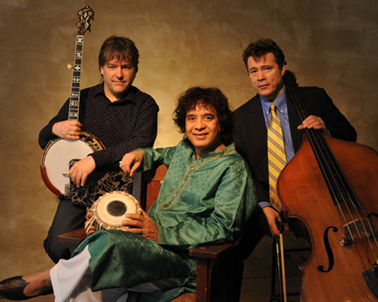
Photo by Jim McGuire
The trio of Béla Fleck, Zakir Hussain & Edgar Meyer was an interesting mix of instruments from different worlds. It was a meeting of highly adept hands and fluid minds. The stage set-up was simple: a folding chair where Béla Fleck sat with his banjo, a microphone stand for Edgar Meyer and his double bass, and a small block platform with a circle of tablas and percussion tools where Zakir Hussain sat cross-legged extending his limbs to dip into rhythm.
These three masters bled music in watercolor layers over a rhythm canvas. They played highly skilled, unorthodox, personal explorations in a unified amalgam of sound into a peak where one, maybe two, dropped away and the song would be over except for the one, or two, who kept playing as if nothing changed. The music passed between them in this way. Not passing solos like tossing a baseball from musician to musician in a game of catch but rather they played together in beautiful, creative, cohesive bedlam. Then the song stopped, for one, maybe two, and the layers, the deep primary colors, stood alone for a moment before bleeding back into the canvas, dripping over the stage, down, across, in a sunset of shared musicianship. It reminded me what good music sounds like.
Zakir Hussain led the primary painted strokes for the first third of the night on the tablas. He is an Indian musician who understands Western music, which allowed him to integrate wholly different sound patterns and rhythms of the tablas into foreign outfits. He blended melodies that never imagined they could meet, like the Indian and Arctic Oceans that flow in entirely different currents, yet both remain bodies of water steeped in waves and life. His hands shook over the tabla heads like newly formed tortillas flying in circled web ripples across a room. Extending out from his still center, his arms grew out to his sides with gypsy flare and buoyancy, as if dancing fingers over water fast enough that you never see the dimple dip of the single notes but only the rippled circles of their collaborative landing. He launched into an impressive solo in the third song weaving silly, recognizable diddies, like the “Happy Birthday” song, into his torrent of percussion, dropping sound out of the tablas with a deep water glug that rolled the euphony into what resembled the orchestration of chimes and vibraphones.
Edgar Meyer dominated the middle third, bleeding pale yellow onto the page. Harnessing his sculptured behemoth of hollowed wood delicately and firm, he pulled deep, expressive sound from the thin arm of the large double bass.The low tone glides of his instrument are not pigeonholed into a specific style or genre of music and so transcended boundaries of melody more easily than the other two more style-specific instruments of banjo and tablas. His fingers ran along the full body of the thick strings down to the throat where he’d cut off the artery of reverberation and continued to play, holding the instrument to a new kind of sound. Alternating the fingers with a bow, he incited beauty and depth into the montage of bleeding colors shading the stage.
Béla Fleck’s bright emerald green didn’t reveal itself until the last third of the night. Béla is a Western musician, wrangling a predominantly Americanized instrument, who understands Eastern music. He transformed the banjo into an instrument that has tasted curry and shivered on the edge of the Great Wall of China. He pulled Indian, Oriental twang inflections out of his banjo with little snippets of Yankee doodle type commonplace jests that related to the pocket most of the instrument’s friends have succumbed to. These were not ordinary sounds from a banjo. The staple twang accustomed to bluegrass barefoot, backwoods hill-stomping, glided into deep, mysterious voices singing with a vibration that played at the center of a steel pipe and wobbled around the edges in calligraphy waves filling the space with a subtle banjo hula twang.
They played together on stage in the fullest sense of the word. Bantering between songs they jarred and jabbed at one another, joking and relating in jests like brothers bound in musical virtuosity, while rippling watercolor layers soaked a canvas in music.


No Comments comments associated with this post